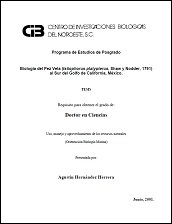Indicadores bioquímico-fisiológicos de calidad larvaria y postlarvaria de camarón blanco Litopenaeus vannamei
Resumen
"En el presente trabajo, se analizaron varios criterios para determinar la calidad o condición fisiológica de larvas y postlarvas de camarón. Las variables analizadas a lo largo del cultivo larvario fueron: composición bioquímica, variables de producción a nivel de desove (numero de huevos y nauplios, porcentaje de fertilización y eclosión) y a nivel de cultivo larvario (supervivencia a distintos estadios), características morfométricas de huevos y larvas, pruebas de estrés a alta concentración de amonio en zoea II y baja salinidad en postlarvas de 2 (PL2) y 20 días de edad (PL20). Para esto se contó con tres grupos de desoves individuales, los cuales conservaron su identidad en todo momento: un grupo de desoves en 1999 a partir de huevo y dos en el 2000 a partir de nauplio.
En primera instancia se estableció el valor de LC50 para 24 horas de exposición al amonio en el estadio de zoea II que fue de 19.4 mg/L. Se encontraron correlaciones significativas entre esta prueba y la supervivencia en los estadios larvarios subsecuentes en la segunda remesa del 2000. Por otro lado, se estableció el nivel de salinidad para ser utilizado en postlarvas de 2 días (PL2), la cual fue de 18 ppm. En la segunda remesa del 2000, se observó una correlación entre esta prueba y la supervivencia en cultivo entre PL1 y PL20. Sin embargo, la prueba de estrés de salinidad en PL20 (exposición en agua dulce) se correlacionó negativamente con la supervivencia a lo largo del cultivo larvario y no se correlacionó con la prueba de estrés en PL2.
Se encontraron correlaciones altamente significativas entre la supervivencia a los diferentes estadios larvarios, en las tres remesas, permitiendo incluso la generación de modelos matemáticos para predecir la supervivencia a postlarva a partir de la supervivencia de zoeas o mysis. El número de nauplios por desove y el porcentaje de eclosión, presentaron alta correlación con la supervivencia en los estadios larvarios, por lo que podrían considerarse como buenos indicadores tempranos de calidad larvaria posterior. Al analizar las variables morfológicas, solo se observaron correlaciones significativas aisladas con otras variables, a pesar de que han sido señalados por diversos autores como indicadores de calidad..." "In the present work, several criteria were analyzed to determine the quality or physiological condition of shrimp larvae and postlarvae. The analyzed variables during larval culture were: biochemical composition, production variables at spawning (number of eggs and nauplii percentage of fertilization and hatching), survival to different larval stage, morphometric characteristics of eggs and larvae and stress tests to high ammonia concentration in zoea II and lower salinity in two days (PL2) and twenty days (PL20) old postlrvae. For this purpose we used three groups of multiple individual spawns with their identity preserved kept at all times: the first one a group of spawns (1999 batch) from egg and the second and third were two groups of spawns (2000 batches) from nauplii.
The value of LC50 for 24 hours of ammonia exposure in the zoea II stage was first established, obtaining a value of 19.4 mg/L. A significant correlation was found between this stress test and survival to the subsequent larval stages for the second batch of 2000.With regard to the stress test using low salinity to exposure PL2, it was established 18 ppm as the best salinity level. A correlation was observed between this stress test and the survival during culture between PL1 and PL20 stages. Nevertheless, the salinity stress test at PL20 to freshwater exposure was correlated negatively with the survival during larvae culture and was not correlated with the stress test in PL2. Highly significant correlations among survival to the different larvae stages were found, in all three batches, allowing the derivation of a mathematical model to predict survival to postlarvae from the survival of zoea or from mysis stages. The number of nauplii per spawn, and the hatching rate, had a significant correlation with survival to larval stages, which indicates that they may be used as good indicators of larvae quality. When analyzing the morphologic variables, some significant correlations were observed with other variables but there was not a clear pattern that would allow to use them as quality indicators of larval performance, in spite of the fact that they have been proposed by diverse authors as quality indicators..."
Colecciones
Ítems relacionados
Mostrando ítems relacionados por Título, autor o materia.
-
PROMOCIÓN DEL PERIFITON PARA EL CULTIVO DE CAMARÓN BLANCO: HACIA UNA ACUICULTURA ECOLÓGICA
DOMENICO VOLTOLINA LOBINA; JUAN MANUEL AUDELO NARANJO; MARIA DEL ROSARIO PACHECO MARGES -
Suelo y Erosión
YOLANDA LOURDES MAYA DELGADO


